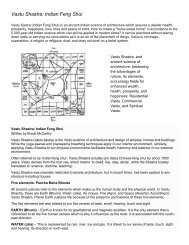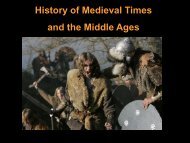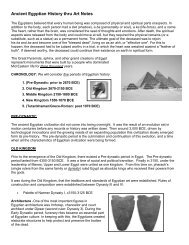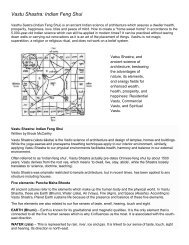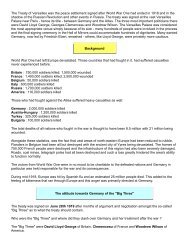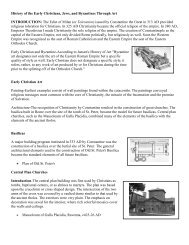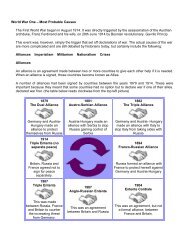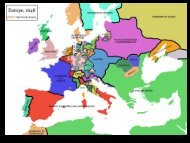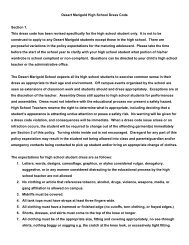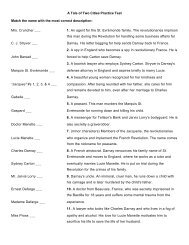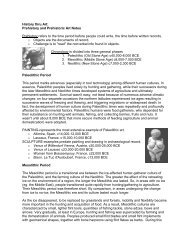Baroque and Rococo notes.pdf - DMHScommunity
Baroque and Rococo notes.pdf - DMHScommunity
Baroque and Rococo notes.pdf - DMHScommunity
You also want an ePaper? Increase the reach of your titles
YUMPU automatically turns print PDFs into web optimized ePapers that Google loves.
The <strong>Baroque</strong> (c. 1600-1750)<br />
<strong>Baroque</strong> was born in Italy, <strong>and</strong> later adopted in France, Germany, Netherl<strong>and</strong>s, <strong>and</strong> Spain. The word<br />
"baroque" was first applied to the art of period from the late 1500s to the late 1700s, by critics in the late<br />
nineteen century. <strong>Baroque</strong> covers a wide range of styles <strong>and</strong> artists.<br />
In painting <strong>and</strong> sculpture we recognize three main forms of <strong>Baroque</strong>:<br />
1. <strong>Baroque</strong> that was primarily associated with the religious tensions within Western Christianity: division on<br />
Roman Catholicism <strong>and</strong> Protestantism. In response to the Protestant Reformation of the early sixteen century,<br />
the Roman Catholic Church had embarked in the 1550s on a program of renewal known as the Counter -<br />
Reformation. As part of the program, the Catholic Church used art of the magnificent display for the campaign.<br />
It was intended to be both doctrinally correct <strong>and</strong> visually <strong>and</strong> emotionally appealing so that it could influence<br />
the largest possible audience. But as the century progressed the style made inroads into the Protestant<br />
countries. Main representatives of this form of <strong>Baroque</strong> were Bernini <strong>and</strong> Rubens.<br />
2. <strong>Baroque</strong> that use revolutionary technique of dramatic, selective illumination of figures out of deep shadow<br />
- a hallmark of <strong>Baroque</strong> painting. Contrary to the traditional idealized interpretation of religious subjects,<br />
<strong>Baroque</strong> realistically presents models from the streets. Caravaggio is key painter of this form of <strong>Baroque</strong>.<br />
3. <strong>Baroque</strong> that was developed mainly in Flemish countries emphasis realism of everyday life. It has been<br />
seen in works of Rembr<strong>and</strong>t <strong>and</strong> Vermeer.<br />
At the same time, scientific advances <strong>and</strong> exploration with the development of the press, forced Europeans<br />
to change the view of the world. New knowledge in astronomy was of great importance. In the eighteen century<br />
scientific literature became so plenteous, that the period has gotten the name “Age of Enlightenment”.<br />
The new <strong>Baroque</strong> style is a dynamic art that reflects the growth of absolutist monarchies <strong>and</strong> is suitable to<br />
manifest power. It is also known as "the style of absolutism". <strong>Baroque</strong> is a style in which painters, sculptors,<br />
<strong>and</strong> architects rummaged emotion, movement, <strong>and</strong> variety in their works. <strong>Baroque</strong> favors higher volumes,<br />
exaggerates decorations, adds colossal sculptures, huge furniture, etc. Sense of movement, energy, <strong>and</strong><br />
tension dominate compositions. Strong contrasts of light <strong>and</strong> shadow often enhance the dramatic effects. In<br />
architecture, there was a special attention given to animation <strong>and</strong> gr<strong>and</strong>eur achieved through scale, the<br />
dramatic use of light <strong>and</strong> shadow.
The <strong>Rococo</strong> (c. 1700 - 1760)<br />
"<strong>Rococo</strong>" describes a movement in the arts in the early 18th century, primarily in France. <strong>Rococo</strong> has been<br />
born from the <strong>Baroque</strong> era, during the Age of Enlightenment. That was a time when new ideas about human<br />
existence were introduced <strong>and</strong> <strong>Rococo</strong> art is the visual representation of the optimism people felt in response<br />
to that.<br />
The word "rococo" is derived from "rocaille", meaning "rock work" or "shell work," a favorite motif of the time.<br />
It stresses purely ornamental, light, casual, irregular design.<br />
<strong>Rococo</strong> is seen both as the climax <strong>and</strong> fall of <strong>Baroque</strong> art. After the heavy works created in the <strong>Baroque</strong><br />
style, artists were ready for a change. The <strong>Rococo</strong> manner was a reaction against the” gr<strong>and</strong> manner" of art<br />
identified with the baroque formality <strong>and</strong> rigidity of court life. The movement toward a lighter, more charming<br />
manner began in French architectural decoration at the end of Louis XIV's reign (d.1715) <strong>and</strong> quickly spread<br />
across Europe. During the regency of Duke of Orleans, regent for the minor heir Louis XV, the formalities of<br />
the court gave way to a more casual <strong>and</strong> intimate atmosphere. <strong>Rococo</strong> art portrayed a world of artificiality,<br />
make-believe, <strong>and</strong> game-playing. Although less formal, it was essentially an art of the aristocracy <strong>and</strong><br />
emphasized what seems now to have been the unreflective <strong>and</strong> indulgent lifestyles of the aristocracy rather<br />
than piety, morality, self-discipline, reason, <strong>and</strong> heroism, which were found in the baroque.<br />
The <strong>Rococo</strong> style is characterized by pastel colors, gracefully delicate curving forms, fanciful figures, <strong>and</strong> a<br />
lighthearted mood (visually <strong>and</strong> physically). The essence of <strong>Rococo</strong> art is light. Extreme highlights are placed<br />
on the subject matter <strong>and</strong> the overall work is light in color, effect, <strong>and</strong> emotion. Artists paid special attention to<br />
fine detail. Form is characterized by delicacy of color, dynamic compositions, <strong>and</strong> atmospheric effects.<br />
Antoine Watteau is considered to be one of the first <strong>Rococo</strong> painters. Others include Jean-Honore<br />
Fragonard, Francois Boucher, Thomas Gainsborough, <strong>and</strong> Giovanni Battista Tiepolo.<br />
Eventually the <strong>Rococo</strong> art was replaced by the more serious style, Neoclassicism. Critics condemned rococo<br />
as "tasteless, frivolous, <strong>and</strong> symbolic of a corrupt society".



